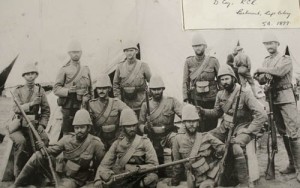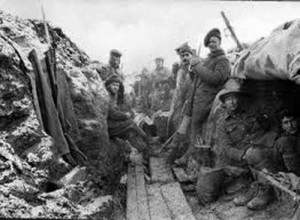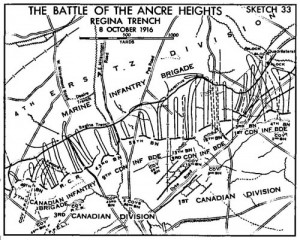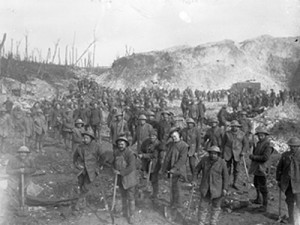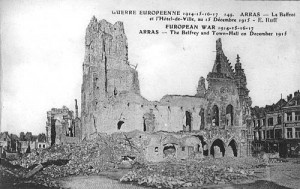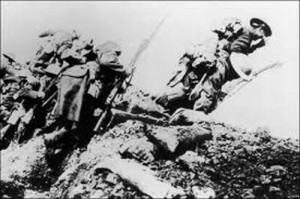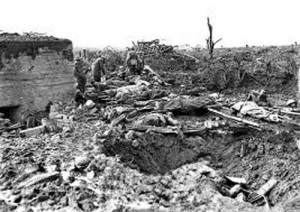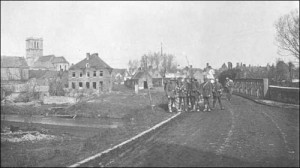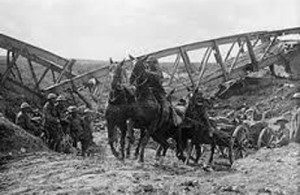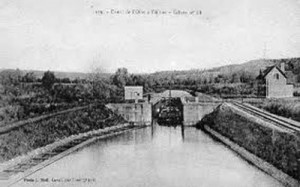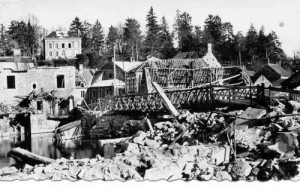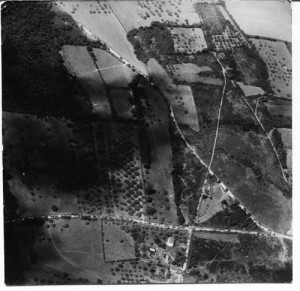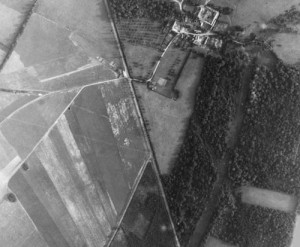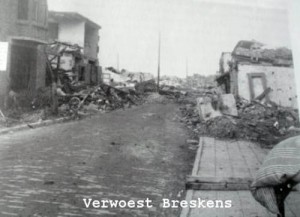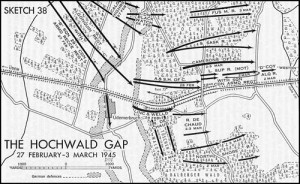Battle Honours
Battle Honours are awarded to selected military units as official acknowledgement for their achievements in specific wars or operations of a military campaign.
The Regiment has been awarded thirty-seven Battle Honours, of which twenty are emblazoned on the Regimental Colour.
Note: The Regiment was awarded an Afganistan Battle Honour in 2014. Not currently on the Regimental Colour, it will be emblazoned on the new one.
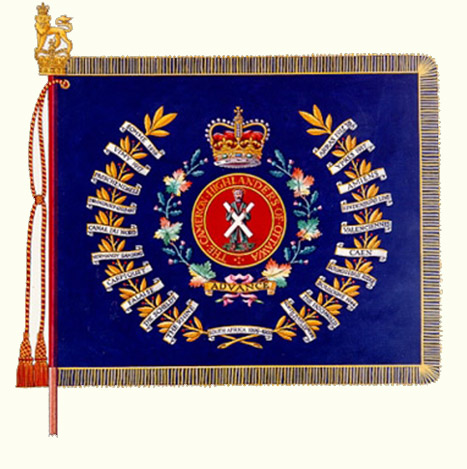
All thirty-seven Battle Honours are listed below, with those approved for display on the Colors in UPPERCASE letters
South Africa
SOUTH AFRICA 1899-1900
World War I
Mount Sorrel
SOMME 1916
Ancre
Ancre Heights
ARRAS 1917, ‘18
VIMY 1917
YPRES, 1917
PASSCHENDAELE
AMIENS
Scarpe 1918
DROCQUORT-QUĖANT
HINDENBURG LINE
CANAL DU NORD
VALENCIENNES
Sambre
France and Flanders 1916-18
World War II
NORMANDY LANDING
CAEN
CARPIQUET
The Orne
BOURGUĖBUS RIDGE
Faubourg de Vaucelles
FALAISE
Quesnay Wood
The Liaison
BOULOGNE 1944
THE SCHELDT
Breskens Pocket
The Rhineland
Waal Flats
THE HOCHWALD
THE RHINE
Zutphen
Deventer
Leer
NORTH-WEST EUROPE 1944-1945
SOUTH AFRICA 1899-1900
Almost 100 members of the unit served with D Coy, 2nd Bn The Royal Canadian Regiment, which was commanded by Capt Maynard Rogers of the 43rd Bn. Pte RR Thompson was awarded the Queen’s Scarf, one of eight hand made by Queen Victoria, to be awarded to the most distinguished soldier of the imperial and colonial forces. Thompson’s scarf is display at the Canadian War Museum in Ottawa.
World War I
Mount Sorrel
The battle took place near Ypres, Belgium from 2 June to 14 June 1916. German troops attacked high ground positions defended by the Canadians, initially capturing the heights at Mont Sorrel. Two divisions of the Canadian Corps recaptured their former positions.
SOMME 1916
The battle of the Somme took place between 1 July and 18 November, 1916, The British Expeditionary Force and the French Army conducted a joint offensive against the Germans, who had held much of the territory since 1914. When the battle had ended, the allies had advanced almost 10 km but were still 5 km from their major objective. More than one million casualties were suffered.
Ancre Heights
This was part of the battle of the Somme and took place between 26 October and 18 November, 1916. The 38th Bn participated in the attacks on Regina Trench and then on Desire Trench. By the end of the battle, the battalion had advanced 800 yards. Members of the 38th Bn were awarded two Distinguished Service Orders, three Distinguished Conduct Medals and five Military Medals.
Ancre 1916
The battle of the Ancre represented the end of the battle of the Somme, including Ancre Heights, and concluded with the capture of Beaumont Hamel, St Pierre Divion and Beaucourt.
ARRAS 1917, ‘18
Arras 1917 was a British offensive near the city of Arras which took place between
9 April and 16 May 1917. The primary objectives were to draw German troops away from a French attack to the South and to capture high ground dominating the plain of Douai.
Arras 1918 was part of the final offensives by the allies against German positions. It was part of the Second Battle of the Somme 1918 and took place between 26 and 29 August 1918.
VIMY 1917
The battle for Vimy Ridge 9-13 April 1917 is probably the most important battle in which Canadian troops participated. 12 officers and 550 other ranks of the battalion were in the first four waves of the attack and suffered 4 officers and 82 other ranks killed. An additional 223 were wounded. The Regiment was awarded one Victoria Cross, three Distinguished Conduct Medals, and 18 Military Medals for actions by its members.
YPRES, 1917
The third battle of Ypres took place between 31 July and 6 November. It ended with the capture of Passchendaele.
PASSCHENDAELE
Passchendaele took place at the same time as Ypres 1917 and the names are often interchanged. The town of Passchendaele lies to the east of Ypres and represents the end of the battle zone.
AMIENS
The battle started on 8 August 1918 and marked the start of the final offensive by the allies, leading to the end of the war.
Scarpe 1918
The battle took place between 25 and 30 August. During this time the battalion crossed the Scarpe river and participated in passing the Fresnel- Rouvroy Line defences.
DROCQUORT-QUĖANT
The Drocqort-Queant line consisted of front line and a support line, each consisting of two lines of trenches. On 2 September 23 officers and 663 soldiers of the battalion started the attack and achieved its objectives the next day. Thirty decorations were earned during this battle, including the Victoria Cross awarded to Private C Nunney.
HINDENBURG LINE
The Hindenburg Line was a major German defensive system running from around Arras to St Quentin. The strongest defended was in the area of the Somme. It was pierced in several places and led to what is known as the Hindenburg Retreat.
CANAL DU NORD
The battle took place between 27 September and 1 October. During this time the 38th Bn crossed the Canal du Nord, passed the Marquoin and Marcoing Lines and stopped at the Douai-Cambrai Road. The intensity of the fighting was again reflected in awards for bravery given to members of the regiment. 29 decorations including four Military Crosses, three Distinguished Conduct Medals, 21 Military Medals and one Belgian Croix de Guerre.
VALENCIENNES
The battle for Valenciennes took place on 1-2 November and was the last major battle in which the regiment participated. On 1 November the 38th Bn advanced from its start off point and ended at a railway line just outside of the city. In the morning of 2 November, troops from the battalion were the first to enter the city itself.
Sambre
Crossing the Sambre Canal was the start of the final offensive by the British on 4 November. After successfully achieving its objectives, under heavy fire, on the 4th, the battalion was relieved and moved into a support position on the 5th.
France and Flanders 1916-18
The 38th Bn arrived in France on 13 August 1916 and more than 200 officers and 3700 troops had passed through it by the end of the war. Of these 766 died and 1950 were wounded. Officers and men were awarded 299 decorations for bravery, including two VCs and the 38th Battalion was awarded 16 Battle Honours.
World War II
NORMANDY LANDING
The Regiment was the only Ottawa based regiment to participate in the landings. The Camerons were the 3rd Canadian Infantry Division’s heavy weapons and supported all units landing on the beaches.
CAEN
Caen was a major objective following the landings. 3rd Canadian Division, including the Camerons, were tasked with capturing several towns on the outskirts of Caen as well as the high ground at Buron. The city was strongly defended and was not considered
‘taken’ until late July.
CARPIQUET
The battle took place 4-6 July 1944 and was an important objective on the way to capturing Caen. The airfield was defended by units of the 1st SS Panzer Division. The Camerons were in support of 8th Bde and were involved in fighting on all fronts. For their actions members of the unit were Mentioned in Dispatches and were awarded a Military Medal and a Military Cross.
The Orne
C Coy in support of 9th Bde participated in the crossing of the Orne river and the capture of the high ground at Buron.
BOURGUĖBUS RIDGE
Bourguébus Ridge is high ground south of Caen. British 8th Corps had been tasked with its capture but was unable to do so. 3rd Cdn Div were then ordered to relieve them and carried on the attack. By 23 July the ridge was secured and the advance continued.
Faubourg de Vaucelles
Vaucelles is a suburb of Caen south of the Orne river. The battle to take it took place 18-19 July 1944.
FALAISE
This battle fought during the period 16-21 August 1944 was the closing battle of the Normandy campaign. Allied forces attempted to trap two German armies in a pocket at Falaise but were unable to prevent the escape of most of them. Camerons paid a high price during the battle. In one day one-third of a platoon had been killed, on another eight men were killed and 16 wounded but the Regiment’s tasks had been achieved.
Quesnay Wood
Quesnay Wood was a heavily fortified German position on the road to Falaise. On 14 August, Operation Tractable started with Canadian forces advancing 8 Km on the first day.
The Liaison
The river Liaison was crossed on 15 August. The river proved to be more of a tank obstacle than originally predicted and some heavy fighting occurred.
BOULOGNE 1944
Boulogne is a major port on the English Channel and its capture was assigned to 3 Cdn Div. The attack began on 17 September and the city was taken on 21 September. The port facilities had been severely damaged and it took some time for them to be operational.
THE SCHELDT
The Scheldt is the river leading from the sea to the port of Antwerp. Operations to occupy both sides of the river and open the port took place in October and November 1944. This became one of the most difficult areas in which to operate as the enemy flooded much of the land making movement a challenge.
Breskens Pocket
Breskens is a town on the south shore of the Scheldt. In October 1944 the German 15th Army was trapped there. Canadians attacked on 6 October until 2 November when the south shore was declared liberated.
The Rhineland
This was a phase of the North-West Europe campaign which included Operations Veritable and Blockbuster and occurred during the period 8 February through 10 March 1945. Cameron machine guns and mortars were involved in all aspects of the operations.
Waal Flats
A bridge over the Waal river had been captured during operation Market Garden. In early November, the Canadians were tasked with defending the area.
THE HOCHWALD
Operation Blockbuster was the capture of the Hochwald Forest, and the town of Xanten which had a bridge across the Rhine. On February 26, 1945 the Camerons led a mass barrage with its machine guns and mortars. Platoons then accompanied units of 3rd Cdn Div as they advanced. Strong opposition was encountered and it was not unitl March 15th that planning could commence for crossing the Rhine into Germany.
THE RHINE
On March 23, 1945 the Regiment again coordinated another ‘pepper pot barrage’ prior to the advance of allied forces. The next morning No 9 Platoon was the first Canadian machine gun platoon across the Rhine.
Zutphen
Following the crossing of the Rhine, 1st and 3rd Cdn Divs were tasked with clearing northeast Holland. The operation commenced April 5, 1945 with the Camerons supporting 3rd Div. By April 8th Zutphen had been cleared.
Deventer
Immediately following the capture of Zutphen, the Canadians continued towards Deventer. The main attack started at noon on April 10, 1945 with 9 Brigade in the lead, supported as usual by the Camerons. Twenty four hours later Deventer was in Canadian Hands.
Leer
Leer is a small port at the junction of the Ems and Leda rivers in northwest Germany and was an important communication centre. On April 28, 1945 the Camerons participated in another combined barrage to cover 9 Brigade as it crossed both the Ems and Leda rivers. The town was reported captured on April 30th.
NORTH-WEST EUROPE 1944-1945
This battle honour was awarded to any Canadian unit which had participated in a major battle in North-West Europe. The Camerons had landed on D-Day and continued in action through North-West Europe into Germany and were involved in most of the fighting done by Canadian forces.

